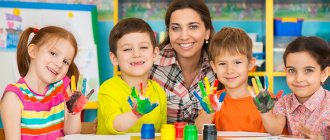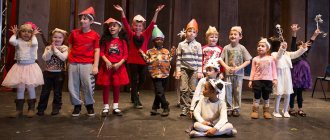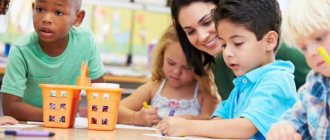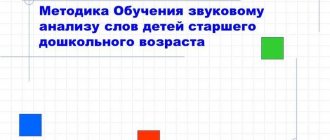Analysis of classes in preschool educational institutions according to the Federal State Educational Standard before. Sample self-analysis of a lesson in a preschool educational institution according to the Federal State Educational Standard before
Kristina Vershinina
Analysis of classes in preschool educational institutions according to the Federal State Educational Standard before. Sample self-analysis of a lesson in a preschool educational institution according to the Federal State Educational Standard before
Analysis of classes in preschool educational institutions according to Federal State Educational Standards for preschool education
General information
1. Topic of the lesson .
2. Date and place of its holding. Who conducts it?
3. Group.
4.Purpose:
• to solve what problems and develop what personality traits of students this lesson ;
•Tasks:
• how the specificity and realism of the goal is realized (from the point of view of sufficient time to complete it, compliance with the children’s preparedness for solving it in previous lessons , the capabilities and abilities of the children);
• how the integration of educational areas is implemented in accordance with the age capabilities and characteristics of students in the classroom .
5. Psychological justification for choosing the form and content of the activity:
• compliance of the lesson with general educational and correctional-developmental goals and objectives, the level of development of students, and their age characteristics;
• implementation of a comprehensive thematic principle (the topic of a particular lesson is chosen in the context of the general topic being studied);
• during the lesson, the joint activity of an adult and children is realized, the main component is interaction.
6. Observing the progress of the lesson
How convincingly, clearly, emotionally were the goals and objectives of the upcoming activity revealed to the students?
How meaningful, interesting and organized was the work?
What knowledge did the students acquire during the lesson :
what social attitudes were formed among the pupils, towards what socially useful
activities prompted their occupation ;
what vital values were formed.
Controllability of the lesson :
• how the opportunity to evaluate intermediate and final results is implemented;
• what conclusions did the students make during the course and at the end of the work;
• what results have been achieved.
How did the lesson the formation of public opinion of the group and individual students on their relationships.
what could be the consequence of this activity for the development of the team, for the formation of its social orientation.
What is its impact on individual pupils:
• emotional and aesthetic responsiveness to beauty in art;
work ethics, artistic activity.
aesthetics of behavior
Methods of work, the nature of relationships, their compliance with educational tasks, age and individual characteristics, the level of development of relationships in the group team.
7. General assessment of the educational event
• To what extent were educational goals and objectives achieved?
• Reasons for successes, failures, mistakes?
• General assessment of the educational value of the work performed.
•Psychological and pedagogical conclusions and suggestions to teachers and students:
• the effectiveness of the lesson in relation to each child;
• analysis of children’s activities (by the teacher)
and
children's self-analysis of their work ;
• reflective moment (the teacher encourages the child to express his attitude to the situation, to his activity).
8. Analysis of the teacher’s activities
Which character traits of the teacher contributed to effective work with students, which, on the contrary, hindered
• the teacher encourages children to show initiative and independence , encourages the manifestation of subjectivity;
• the teacher stimulates and encourages individual achievements of children;
What pedagogical abilities were demonstrated when carrying out effective work with students?
• the teacher takes into account the characteristics of each child (pace of activity, emotional state, level of development of mental processes, temperament)
• the teacher “sees”
each child: helps, stimulates, encourages.
Sample self-analysis of a lesson in a preschool educational institution according to the Federal State Educational Standard for Preschool Education
Goal: To develop children's interest in knowledge about vegetables through the integration of educational areas : cognition, communication, socialization, artistic creativity, health.
Tasks:
— Formation of children’s ideas about vegetables, the place of germination and their preparation for the winter;
-To strengthen children’s ability to describe vegetables according to their characteristic features, according to the diagram;
- Improving the ability to construct your statements grammatically correctly and consistently;
-Expand the active vocabulary, activate the names of vegetables in children’s speech.
-Continue to develop in children the ability to distinguish and name colors, to practice comparing objects by color;
-Encourage children to answer questions by pronouncing words clearly.
-Developing children’s ability to coordinate movements with text, understand and follow verbal instructions;
-Development of visual perception and memory, motor imagination and coordination of movements;
-Development of fine general and fine motor skills of the hands;
-Developing a friendly attitude towards peers;
-Creating a favorable emotional atmosphere and conditions for active play activities of children.
Organizational activities, preparation for class
The lesson was carried out in accordance with the notes. The abstract was compiled independently , in accordance with the objectives of the educational program corresponding to the given age of the children. To implement each task, techniques were selected in an interesting and entertaining form.
At every moment of the lesson there were visual aids that stimulated and activated the children’s mental activity. The manuals are of sufficient size and aesthetically designed. Their placement and use was rational, thoughtful in the learning space and in the lesson .
during the lesson to enhance emotional perception. Organizational reception "Welcome"
in poetic form" was aimed at developing communicative skills, establishing friendly relationships both within the children's team and between guests and children.
The lesson is dynamic , it includes techniques that provide for a quick change of activity. Conversation - sitting on chairs, moving around the group while looking for a way out of a problem situation with a hare - going to the garden, working with dough, developing fine motor skills of the hands - sitting on chairs, search activity - standing, working with cereals “Find a vegetable”
, logorhythmic exercise -
“walking in the garden”
.
A quick rotation of techniques and changes in poses during the lesson made it possible to avoid fatigue in children.
Didactic activities of the teacher
All aspects of the lesson are logical and consistent, subordinated to one topic. the educational areas of Cognition were integrated into the lesson : Reinforced the ability to describe a vegetable according to its characteristic features, according to the diagram; developed the ability to distinguish and name colors;
Communication: children participated in the general conversation, listened without interrupting their peers; activated the children's vocabulary using words - the name of vegetables, practiced coordinating nouns and adjectives; “Socialization”
independently express goodwill and empathy. Artistic creativity: Improved children’s ability to roll plasticine between their palms with straight movements, reinforced pressing techniques, developing fine motor skills of the hands. Physical Culture; developed motor imagination and coordination of movements.
Health: formed children’s ideas about vitamins and their importance. The techniques in the lesson were of a playful nature and were based on playful learning situations.
Using the Vegetable Garden
, helped in an interesting playful way to implement the main educational task - the formation of children’s understanding of vegetables and the place where they grow. My role was limited to learning to give detailed answers. This helped to achieve optimal results.
At every moment of the lesson , I tried to guide the kids to find solutions to the problem, helped them gain new experience, activate independence and maintain a positive emotional attitude.
The creation of search, problem situations intensified the mental and speech activity of children,
The specifics of working with children in the classroom were reflected in a person-centered approach. She encouraged timid children and praised them in order to consolidate their situation of success.
During the lesson , I tried to communicate with the children on the same level, tried to maintain the children’s interest in the lesson throughout the entire time.
The outcome of the lesson was organized in the form of a game problem situation “Guess the treat?”
so that during it you can check the quality of assimilation of the material.
Due to the fact that the children are small and there were many choral responses, I plan to pay special attention to individual responses. It is also necessary to achieve clear pronunciation of words. Work on sound pronunciation, expand active and passive vocabulary. But, despite these difficulties, I believe that all the program tasks I set during the lesson were solved .
Why is debriefing done?
You may be interested in: Do you know the meaning of the word “brow”?
Using the example of analyzing the activities of a kindergarten teacher, we can determine:
- Presenter professional training.
- His ability to find an individual approach to a child and work with a group of children.
- Ability to maintain a level of interest in the learning process.
- Identify errors and find ways to correct them.
A good teacher always has something to learn in an open lesson.
In the process of analyzing a lesson for kindergarten teachers, its organization is assessed. It is important that there is enough teaching material for all children. If a drawing lesson using a template is provided, then all children should be provided with paper, pencils or felt-tip pens. Then the stages of logical construction of the lesson are considered.
Why are open lessons held?
An example of an analysis of classes in kindergarten is the assessment by teachers of other kindergartens of an open lesson.
Evaluation of an open lesson is carried out according to the same scheme as self-analysis. The readiness of the children for the lesson is noted and how the teacher helped them cope with the excitement of the presence of guests, introduced them to the topic of the lesson, formulated the task, and set motivation.
Teachers note how well children are organized, whether teaching methods have been chosen correctly, how to stimulate children’s cognitive activity and retention of attention. Analyzing the course of classes, they note how time was distributed for different types of activities in terms of content and form of perception. During the discussion, guests explore whether the chosen structure of the lesson is justified, how each stage of the lesson is worked out, as well as the smooth transition from one stage to another.
Analysis of an open lesson
When analyzing the lesson plan in kindergarten, it is noted that children learned to break the text into parts, the ability to use the singular, plural, and change words using endings in the necessary cases was consolidated. Thematic pictures were used during the lesson, the structure of the lesson was logically justified. The teacher managed to attract and interest the children and maintain their attention throughout the lesson. The training room was well prepared and ventilated. The children did some exercise during the lesson. The teacher was recommended to more actively encourage individual successes and try to see the characteristics of each child.
Analysis of lessons, the teacher’s thoughtful attitude to the educational process, and attentive attitude towards each child will certainly help make classes useful and interesting.
Source
Logical stages of lesson construction
You might be interested: Wake is... Origin and meaning of the word
In the introductory part, the kids are explained what and why they will do; in the main part, they begin to do it. Here they need help; it is especially important for the teacher to understand who is having difficulty performing and for what reasons. According to educational standards, development is carried out in five directions: cognitive, speech, social and communicative, artistic and aesthetic, and physical. Tasks are selected according to age.
At the end of the lesson, you need to express approval and support for the children.
Why are the analysis results needed?
The consequence of a competent analysis of the activities of a kindergarten teacher, for example, is to work on mistakes and identify positive experiences that can be used when planning further work.
To do this, they carry out operational self-analysis, which allows one to analyze daily observations, and then summarize the results for a certain period and draw useful conclusions. During thematic analysis, a specific area is examined (FISO, FEMP).
The report describes the work done, how it was organized, goals, successes, and evaluates the degree of results achieved in comparison with the expected ones.
How to create a lesson plan
The work of a teacher in a kindergarten is carried out according to a plan, which is drawn up taking into account the characteristics of children at a certain age, daily routine, and dosed load. The educational process should be continuous and systematic, helping the child to actively explore the world around him and taking into account individual characteristics.
The preschool educational institution employee draws up plans for the future and for each day, and based on the lessons conducted, he compiles a report on the work of the teacher in the kindergarten. It consistently tells what work was planned, how it was carried out, what changed in the children’s behavior, and what they learned.






